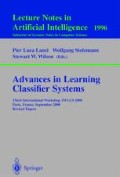Abstract
In this paper we propose an evolutionary approach to aggregate and control multiple Learning Classifier Systems (LCS) within a tree architecture. Our approach relies on two main principles. First, to base the tree control flow on a metaphor of a classifier attribute - strength, taking it as an expression of the classifier system excitement at a given time step. The tree control mechanism takes the excitement level of standard classifier systems to feed higher-level coordinator classifier systems, which will become responsible for choosing the appropriate host agent behavior. The second principle consists in relying on evolution to be the judge of the suitability of LCS aggregation. We believe that a “running time” aggregation mechanism will be useless if it is not provided a method to assess the suitability of the resulting structure. In the approach we propose, this role is played by simulated evolution of synthetic LCS based agents. The test-bed of our claims was Saavana, an Artificial Life environment modeled after a natural ecosystem where synthetic LCS based antelopes were subjected to simulated evolution. The preliminary results showed us that this approach improves the progressive adaptation of agent populations to the environment they are facing and looks promising regarding the emergence of high-level agents capable of dealing with multi-goal tasks.
Access this chapter
Tax calculation will be finalised at checkout
Purchases are for personal use only
Preview
Unable to display preview. Download preview PDF.
References
Holland, J., Adaptation in Natural and Artificial Systems, MIT Press, 1992.
Brooks, R. A., “A Robust Layered Control System For A Mobile Robot”, IEEE Journal of Robotics and Automation, Vol. RA-2, n° 1, 1986.
Colombetti, M. and Dorigo, M., “Learning to Control an Autonomous Robot by Distributed Genetic Algorithms”, Proceedings of From Animals to Animats, Second International Conference on Simulation of Adaptable Behavior (SAB92), pp. 305–312, MIT Press, 1992.
Dorigo, M. and Sirtori, E., “ALECSYS: A Parallel Laboratory for Learning Clasiifir Systems”, Proceedings of the 4 th International Conference on Genetic Algorithms, USA, 1991.
Dorigo, M. and Schnepf, U., “Genetics-based Machine Learning and Behavior Based Robotics: a New Synthesis”, IEEE Transactions on Systems, Man and Cybernetics, 23, 1, 1993.
Tinbergen, N., The study of instinct, Oxford University Press, 1978.
Colombetti, M., Dorigo, M. and Borghi, G., “Robot Shaping: The Hamster Experience”, Proceedings of ISRAM’96, Sixth International Symposium on Robotics and Manufacturing, M. Jamshidi et al. (Eds.), May 28–30, 1996, Montpellier, France.
Lattaud, C., “Non-Homogeneous Classifier Systems in a Macro-Evolution Process”, Proceedings of 2nd International Workshop on Learning Classifier Systems, USA, 1999.
Wilson, S. W., “ZCS: A Zeroth Level Classifier System”, Evolutionary Computation, Vol. 2, 1, pp. 1–18, 1994.
Dawkins, R., O Relojoeiro Cego, Universo da Ciěncia. Edic⇇∼es 70, 1986, Portugal.
Iba, H., de Garis, H., and Higuchi, T., “Evolutionary learning of predatory behaviors based on structured classifiers”, From Animals to Animats 2: Proceedings of the Second International Conference on Simulation of Adaptive Behaviour, Meyer, J. A., Roitblat, H. L. and Wilson, S. W.(editors), MIT Press, 1993.
Author information
Authors and Affiliations
Editor information
Editors and Affiliations
Rights and permissions
Copyright information
© 2001 Springer-Verlag Berlin Heidelberg
About this paper
Cite this paper
Sepúlveda, T., Rui Gomes, M. (2001). A Study on the Evolution of Learning Classifier Systems. In: Luca Lanzi, P., Stolzmann, W., Wilson, S.W. (eds) Advances in Learning Classifier Systems. IWLCS 2000. Lecture Notes in Computer Science(), vol 1996. Springer, Berlin, Heidelberg. https://doi.org/10.1007/3-540-44640-0_12
Download citation
DOI: https://doi.org/10.1007/3-540-44640-0_12
Published:
Publisher Name: Springer, Berlin, Heidelberg
Print ISBN: 978-3-540-42437-6
Online ISBN: 978-3-540-44640-8
eBook Packages: Springer Book Archive

